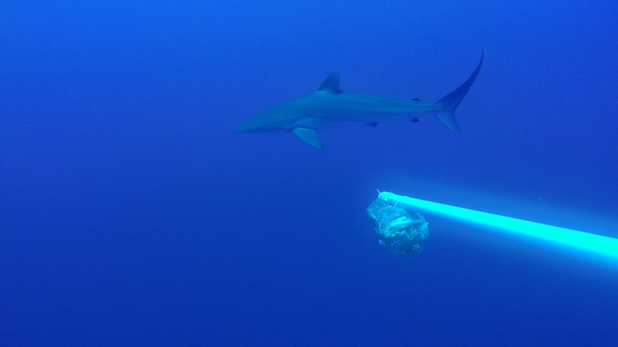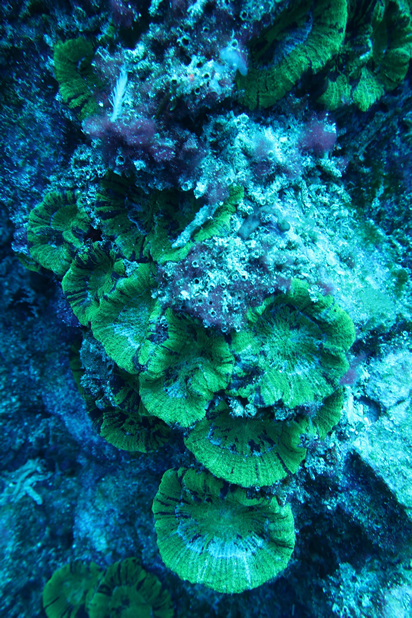Expeditions: St Peter and St Paul Archipelago – 2018
[Portuguese version below]
The yearly Programa de Monitoramento de Longa Duração das Comunidades Recifais das Ilhas Oceânicas
Brasileiras (PELD-ILOC) expedition to St Peter and St Paul’s Archipelago took place between 16th and 30th
September. St Peter and St Paul’s Archipelago (SPSPA) is a seamount of the Atlantic ridge, situated 1100km from
the Brazilian coast (00°55’N, 29°21’W). It rises just 18 meters above the surface, and consists of 11 small, barren
rocky islands. Due to its isolation and geographical position, biodiversity is low compared to the coast with some
functional groups missing or composed of few individuals and species, especially fish species associated to soft
bottoms and roving herbivores. Instead, the archipelago harbours several endemics such as the damselfish
Stegastes sanctipauli, Oblique butterflyfish Prognathodes obliquus and the fairy basslet Choranthias
salmopunctatus. The PELD program includes fish and benthos surveys on all the oceanic islands in Brazil (Atol das
Rocas, Trindade Island, Fernando de Noronha and the SPSPA).
The expedition consisted of Moysés C. Barbosa (LECAR -UFF), Larissa Benevides (UFAL), Caio Pimentel (UFES)
and Thayná J. Mello (ICMBio). Among the activities developed during the expedition, the researchers monitored
several parts of the marine ecosystem, such as: The reef fish assemblage (through underwater visual census and
Baited remote underwater video), benthic cover composition and the population structure of the Aratu crab (Grapsus
grapsus). In addition, other activities of the researchers associated with the project were carried out, including
collection of organisms and macroalgae that will be studied for bioprospection of compounds of medical and
pharmaceutical importance.
Weather was good during the expedition, and data was collected successfully. Abundance and biomass of fish is
high in the archipelago, due to it being subjected to less stressors than the coast, although fishing do occur. Water
visibility ranged between 30 to 50 meters, and we had the pleasure to also observe oceanic species such as large
devil rays (Mobula tarapacana) and wahoos (Acanthocybium solandri) under water in addition to large numbers of
Caranx lugubris, Elagatis bipinnulata, Melichthys niger and moray eels (mainly Muraena pavonina).
Expedições: Arquipélago de São Pedro e São Paulo - 2018
A expedição anual do Programa ecológico de Longa Duração das Comunidades Recifais das Ilhas Oceânicas
Brasileiras (PELD-ILOC) esteve no Arquipélago São Pedro e São Paulo, a expedição ocorreu entre os dias 16 e 30
de setembro. O Arquipélago de São Pedro e São Paulo (ASPSP) faz parte de uma cordilheira submarina do
Atlântico, situado a 1100 km da costa brasileira (00 ° 55’N, 29 ° 21’W). O arquipélago se eleva a apenas 18 metros
acima do nível do mar e consiste em 11 pequenas ilhas rochosas. Devido ao seu isolamento e posição
geográfica, a biodiversidade é baixa em comparação com a costa, com alguns grupos funcionais ausentes ou
compostos de poucos indivíduos e espécies, especialmente espécies de peixes associadas a fundos não
consolidados e herbívoros vagueadores. Em vez disso, o arquipélago abriga várias espécies endêmicas, como a
donzelinha Stegastes sanctipauli, o peixe-borboleta de profundidade Prognathodes obliquus e serranídeo de
fundo Choranthias salmopunctatus. O programa PELD inclui levantamentos de peixes e bentos em todas as ilhas
oceânicas do Brasil (Atol das Rocas, Ilha da Trindade, Fernando de Noronha e SPSPA).
A expedição foi formada pelos pesquisadores Moysés C. Barbosa (LECAR-UFF), Larissa Benevides (UFAL), Caio
Pimentel (UFES) e Thayná J. Mello (ICMBio). Entre as atividades desenvolvidas durante a expedição, os
pesquisadores monitoraram vários aspectos do ecossistema marinho, tais como: A assembleia de peixes recifais
(através de censo visual subaquático e vídeo remoto subaquático com isca - BRUVS), composição da cobertura
bêntica e a estrutura populacional do caranguejo Aratu (Grapsus grapsus). Além disso, outras atividades dos
pesquisadores associados ao projeto foram realizadas, incluindo a coleta de organismos e macroalgas que
serão estudados para a bioprospecção de compostos de importância médica e farmacêutica.
As condições meteorológicas foram boas durante a expedição e os dados foram coletados com sucesso. A
abundância e a biomassa de peixes são altas no arquipélago, devido a estarem sujeitas a menos estressores
comparados a costa, embora exista pesca. A visibilidade da água variou entre 30 a 50 metros, e tivemos o prazer
de também observar espécies oceânicas como grandes raias (Mobula tarapacana) e cavalas (Acanthocybium
solandri), além de grandes quantidades de xaréu preto (Caranx lugubris), peixe rei (Elagatis bipinnulata), cangulo
preto (Melichthys niger) e moréias (principalmente Muraena pavonina).

Figure 1: Figure 1: Blacktip shark (Carcharhinus falciformes) recorded by BRUVS.

Figure 2: Queen angelfish (Pomacanthus paru) and the blue variation of the species, found only in the SPSPA.

Figure 3: Colony of Scolymia wellsi, a common coral in the SPSPA.

Figure 4: The PELD team on the scientific research station at St Peter and St Paul’s Archipelago
Written by: Moysés C. Barbosa |













